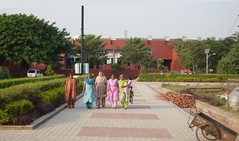Posts Tagged "people"
How the Internet can get the benefits of scientific research out to the public faster
Here is a video of how technology that many people have in their home can be used in ways not intended by the manufacturer. This is interesting, but even more interesting is the wider trend this represents, as Johnny Lee describes – how the Internet and new media formats such as YouTube for video distribution can quickly spread ideas to thousands of people. Not just for persuasive purposes, but to do real good, allowing any teacher or parent to create their own interactive whiteboard using a Wii remote and some cheap hardware. Scientists are already starting to talk about how they can rethink the way research is done for this information-rich, hyper-connected age we live in. It’s really exciting that scientists might finally have a way to directly explain their work to the public without having to go through journalists who don’t always understand the science, or who are encouraged to take the most sensational angle.
Exciting times are ahead, I’m sure …
Malcolm Gladwell on spaghetti sauce
Just came across this talk by Malcolm Gladwell telling a story of how the food industry learned about the need to identify different types of tastes rather than looking for the “most popular”. This ties in neatly with some of the ideas I have blogged about before about the need for anyone developing a product or service to find out your user personas and decide which ones to target, rather than taking a one-size-fits-all approach.
A feast for the senses; a land at peace
India 10: Reflections on India
So, my three week trip to India is nearing its end. Tomorrow I fly back to Mumbai and on Wednesday back home. As I reflect on my time in India my feelings are overwhelmingly positive. From day one, India has blown away all expectations. I have to confess I was pretty prejudiced about India. I imagined a disease ridden place with rubbish and bodies in the streets and destitute people all around. I couldn’t have been more wrong. Yes there is more rubbish than you would see elsewhere – but not in the streets, the people are very proud and streets and highways are regularly swept clean. You have to look hard to see the rubbish – down back alleys and at the edges of towns. There are no bodies in the street either. That seems to be pure myth. The only thing we did see occasionally is sarcophaguses of mummified religious leaders by the roadside, as sort of shrines.
The most significant thing that strikes me about India is the colours.
Read MoreLook at the strange cow-eating white men!
India 4: Strangers in a strange land
From the first night Steve and I went for a walk around Ahmedabad, we noticed that people were looking at us a little strangely. Not with any kind of negativity or judgement but more a sort of genuine fascination – the way you might find your eyes drawn to a person with bright green hair or an unfortunate birthmark. It took a little getting used to. After a couple of days it struck us – we were the only white people in town – even in the hotel. It seems the local people rarely see any non-Indians.
It turns out that Westerners rarely come to Gujarat, so in a way it was the ideal introduction to India. We realised just how rare it must be when we asked a rickshaw driver to take us to Le Meridien and he’d never heard of it or been there, even after we got there (Le Meridien is the most expensive hotel in town).
But it was also interesting to realise that we’d been there a couple of days without even realising we were in a minority. I found that quite weird at the time – my last experience of being in a minority was in Atlanta, Georgia, USA where everyone was black. I felt quite nervous and like I stood out, I was acutely aware of being different. Not so here. There’s something about the people and their attitude that makes you feel very safe and at ease. It would take me a couple more weeks of being in India to really be able to put it into words.
On our first evening as we sat in a restaurant a little Indian girl of 10 or so years old and said in her best attempt at English. “Hello. What is your name?”. Her mother stood behind her and looked on proudly. We introduced ourselves, asked her name, exchanged smiles and she went away happy. This sort of thing happened all the time.. Children would call out “Hello How Are You” in the street as we walked past. We even had a few shouts of “Welcome to India!” which was really touching. But this was nothing compared to what happened to us at Lothal.
Read More



